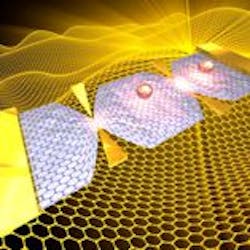Barcelona, Spain--Among its many other amazing properties, graphene is able to convert a single photon that it absorbs into multiple hot electrons, according to a paper in Nature Physics authored by researchers at The Institute of Photonic Sciences (ICFO) in collaboration with researchers from the Massachusetts Institute of Technology (MIT; Cambridge, MA), Max Planck Institute for Polymer Research (Mainz, Germany), and Graphenea S.L. (Spain). Furthermore, the higher the photon's energy, the larger the number of hot electrons created by the graphene.
Hot-electron multiplication is an essential ingredient for light harvesting with very low energy loss. Moreover, the combination of broadband absorption and hot-carrier multiplication enables graphene to efficiently convert light energy from the full solar spectrum into electricity.
The experiment was conducted using a pump-probe technique with ultrahigh time resolution. Researchers excited single-layer graphene with a well-known number of absorbed photons and photon energy (wavelengths), and measured the resulting hot-electron distribution with a terahertz pulse. They found that higher photon energies (such as violet) led to higher numbers of hot electrons than lower photon energies (such as infrared), for a constant number of absorbed photons. The linear scaling of the number of hot electrons with photon energy shows that graphene converts light energy into electricity with very high efficiency.
"It was known that graphene is able to absorb a very large spectrum of light colors. However now we know that once the material has absorbed light, the energy conversion efficiency is very high. Our next challenge will be to find ways of extracting the electrical current and enhance the absorption of graphene. Then we will be able to design graphene devices that could generate efficient solar power," conclude ICFO paper authors Tielrooij and Koppens.
SOURCE: The Institute of Photonic Sciences (ICFO); http://www.icfo.eu/newsroom/news2.php?id=&id_news=1884&subsection=1
About the Author

Gail Overton
Senior Editor (2004-2020)
Gail has more than 30 years of engineering, marketing, product management, and editorial experience in the photonics and optical communications industry. Before joining the staff at Laser Focus World in 2004, she held many product management and product marketing roles in the fiber-optics industry, most notably at Hughes (El Segundo, CA), GTE Labs (Waltham, MA), Corning (Corning, NY), Photon Kinetics (Beaverton, OR), and Newport Corporation (Irvine, CA). During her marketing career, Gail published articles in WDM Solutions and Sensors magazine and traveled internationally to conduct product and sales training. Gail received her BS degree in physics, with an emphasis in optics, from San Diego State University in San Diego, CA in May 1986.
